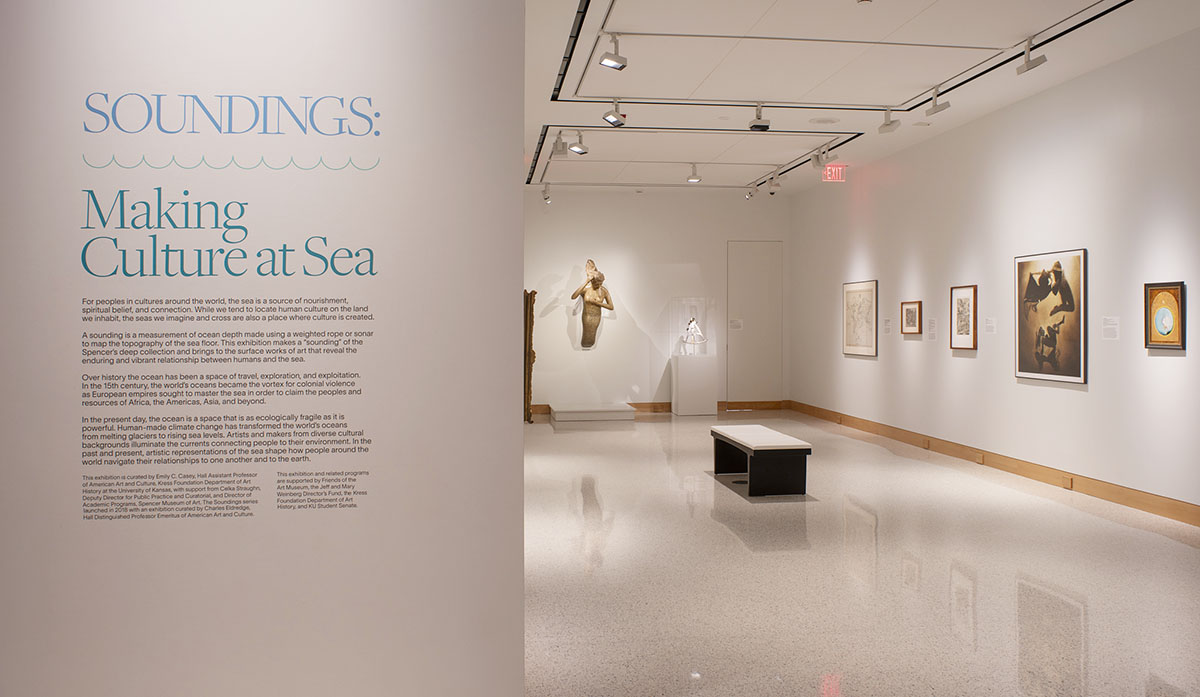Spencer Museum of Art exhibition ‘Soundings’ lets viewers imagine the ocean

Date and author
author
Press release
LAWRENCE — Visitors can dip their toes into the art and idea of the ocean in the exhibition “Soundings: Making Culture at Sea,” on display now through Dec. 14 at the Spencer Museum of Art at the University of Kansas.
Curated by Emily Casey, Hall Assistant Professor of American Art and Culture in KU’s Kress Foundation Department of Art History, and Celka Straughn, museum deputy director for public practice and curatorial, “Soundings” is drawn primarily from the Spencer’s own collection, with some loans from KU Libraries.
It includes works like the exquisite, late-period Winslow Homer watercolor painting “West India Divers” and a life-size carved-wooden mermaid that once served as an advertising sign above a 19th-century seaside supply shop.
With photographs of Greenland glaciers, it draws a connection between 19th-century Arctic explorer Lewis Lindsay Dyche, after whom KU’s Dyche Hall — home to the Biodiversity Institute and Natural History Museum — is named, and the KU scientists exploring the effect of climate change on Antarctic ice sheets today.
And while Casey came to KU from an East Coast college just a couple of years ago, she noted that the existence of these materials proves that oceans have long been relevant to the people of Kansas.
“When I came here, I thought, ‘What does it mean to teach a class about the art of the sea in a landlocked state?’ But I think the exhibition really helps to highlight some of the ways in which there are so many connections to the ocean here,” Casey said. “And part of that is the fact that there were people who explored maritime spaces who have connections to KU. Dyche is an example.”
“Soundings” is divided into four sections, Casey said.
In the maps section, a Mercator projection is contrasted with Buckminster Fuller’s radically different “Dymaxion” representation of the globe.
The second section, about crossing or living alongside the ocean, is where Homer’s painting of shell divers is displayed alongside a screen showing “Encore (Paradise Omeros: Redux),” a four-minute video by British artist Isaac Julien that reflects on his own Caribbean heritage.
The third section, in which the Greenland photographs are located, emphasizes the way artists play an important role in raising awareness about the current ecological threats to the ocean.
The final section, about the ocean as trade route, features a tea chest, porcelain vessels and textiles, among other works.
Casey said the exhibition grew out of her area of research.
“I focus on the context of the early United States — so the late colonial, early national period,” she said. “My book project, which I’m working on right now, examines how people imagined and represented the ocean around the time of the American Revolution.”
Casey said she would teach her fall course, Art and the Sea: From the Age of Sail to the Age of Climate Change, in conjunction with the exhibition, calling it “a great example of collaboration between the museum and the classroom.”